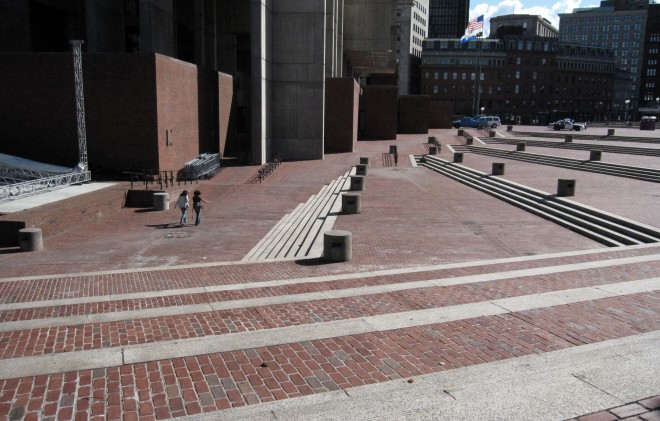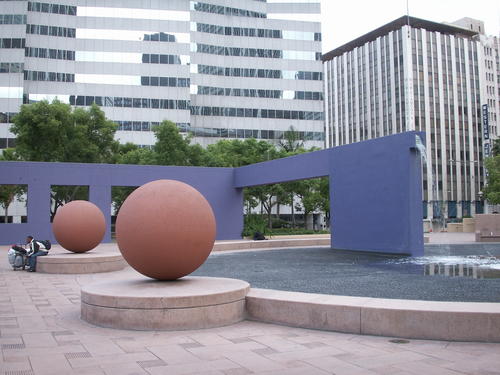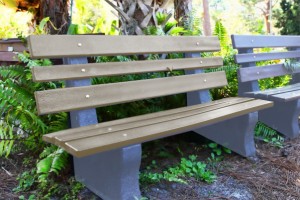A biweekly newsletter with public space news, resources, and opportunities.
A curated dispatch on all things public markets plus the latest announcements from the Market Cities Program.

Albany, NY - Standing amidst acres of granite paving and empty benches, with four imposing grey towers behind her, United States Secretary of the Interior Sally Jewell announced plans this week for a set of important amendments to the National Historic Preservation Act.
“Many people are not aware that awful spaces like Empire State Plaza are under serious threat across the country. Our new Failed Public Space amendment is designed to protect these spaces, and to ensure that future generations of Americans can continue to not use them.”
The National Historic Preservation Act, passed in 1966, was created to “to identify, evaluate, and protect America's historic and archeological resources.” The act did not take into account the need to eventually protect the empty, soulless, windswept public spaces, and the mind-numbingly monotonous suburban developments that were being built at the time.
“The way that these plazas inhibit the natural human instinct to connect with others is a unique part of our cultural heritage, and it is as worthy of preservation as the Petroglyphs on Indian God Rock or Jefferson’s home at Monticello,” said National Register program manager Paul Loether. “We need to guarantee that these places not be experienced in the way they were intended to not be experienced.”

Along with Empire State Plaza, the Failed Public Space amendment will protect City Hall Plaza in Boston, Pershing Square in Los Angeles, and the grounds of the Guggenheim Museum in Bilbao.
“I was pleased to see the inclusion of my Guggenheim on this list,” commented renowned architect Frank Gehry. “I designed the area around the museum to be so off-putting and isolating that not a single pitiful human soul could interrupt the ultimate artistry of my masterpiece.”
When asked about the inclusion of foreign sites on the list, Loether responded: “Well, in a way, aren’t all bad public spaces American? Unfriendly, uncomfortable, and unloved public spaces are an important part of our cultural identity at home, and around the world.”
Loether went on to explain the importance of protecting these absolutely god-awful voids: “The Department has been tracking a worrisome trend - communities are organizing to transform these national treasures into places where people actually want to be.”

Rogue activists, sometimes referred to as Placemakers, have been staging interventions in these wastelands—transforming them into hotbeds for such historically inaccurate activities as kissing, smiling, mingling, putting feet in fountains, and generally having fun.
Most alarmingly, many of these groups are using techniques that don’t permanently alter the physical space, leaving the Department with limited means to protect failed spaces from their most stubborn obstacle: people.
“It turns out you can ruin everything that is so wonderful about the emptiness of a place like City Hall Plaza by pulling up some food trucks, putting out umbrellas, and reminding people that they might want to be there. Before this amendment, there was nothing we could do to stop it,” commented Secretary Jewell.
“We're facing a situation in Columbus, Ohio, where librarians are starting to use their failed plaza for storytime. How is anyone going to sense the intended loneliness and despair of a place when it is filled with the laughter of children?” she added.
The Failed Public Space amendment is one of several the Department is proposing to protect vulnerable icons of our 20th century approach to public spaces, city planning, and transportation. Jewell is gathering support on Capitol Hill so the Department can move quickly to protect key areas of auto-oriented sprawl and sidewalk-free residential development.

Senator James Inhofe is a vocal early supporter of the proposed amendments. “Many of our spaces should stay unused, void of pleasure and shared value. This is an important legacy of America, and a legacy that we have successfully exported abroad. They are as worthy of preservation and subsidy as Corn Flakes, the NFL, and fossil fuel dependence,” said the Senior Oklahoma Senator and Chairman of the Committee on Environment and Public Works.
The Department of the Interior is launching a social media campaign to build support for the amendments. They are encouraging citizens to post pictures of failed public spaces and terrible development patterns with the tag #SaveFailedSpaces.
Secretary Jewell closed her remarks with a stark image and a call to action. “When I imagine my grandchildren walking or biking to meet friends and neighbors at Pershing Square--instead of driving quickly past it--I know we have to act immediately and decisively.”
Here are some more of the day's highlights:

Starbucks Announces #PlaceTogether Campaign
In an effort to heal the overwhelmingly negative PR generated by their ill-conceived #RaceTogether campaign, Starbucks announced plans today for a new initiative dubbed #PlaceTogether. Already up and running in several test markets, #PlaceTogether encourages Starbucks employees and customers to discuss how to improve the public spaces in their city. “That #RaceTogether thing was just stupid.” said Jackie, a barista in Baltimore. “But talking about how to get a dog park going across the street? I can get into that.”
-------------

American Planning Association Launches #ILookDown Campaign
In response to the American Institute of Architects’ #ILookUp campaign, APA has announced their campaign #ILookDown to celebrate what planners do to the built environment. "Most people think Planning is a boring profession, but even our smallest moves can impact millions of lives. I just drew a line that displaced thousands of people!" said Joe Corb, an associate city planner in Milwaukee. "If you want to feel like a god everyday, become a planner."
-------------

Tactical Urbanists Follow Book Launch with Full Ground Assault
With the recent release of their new book, Tactical Urbanism, Mike Lydon and Tony Garcia have taken their interventionism to a whole new level. Advocates of this bottom-up approach to urban transformation are launching full scale military-style campaigns in cities across the country in an effort to improve city space by and for the people. As of last night, yarnbombed tanks were seen rolling into Cleveland leaving protected bike lanes, movable seating, and giant chess sets in their wake. A complete overthrow of Raleigh, NC is expected later this week.
--------------

What Color is this Bench?
After an Instagram post of a park bench photo went viral, the landscape architecture world is ablaze with controversy over its true color. While some assert the bench is black and blue, others only see white and gold. Scientists are calling this an unparalleled viral response to a common physical phenomenon, but the debate within the profession is getting personal. “I’ve concluded that it is clearly white and gold,” said James Corner ASLA, “What is wrong with you people?”
The rich text element allows you to create and format headings, paragraphs, blockquotes, images, and video all in one place instead of having to add and format them individually. Just double-click and easily create content.
The rich text element allows you to create and format headings, paragraphs, blockquotes, images, and video all in one place instead of having to add and format them individually. Just double-click and easily create content.
Body Text Body Link
The rich text element allows you to create and format headings, paragraphs, blockquotes, images, and video all in one place instead of having to add and format them individually. Just double-click and easily create content.
Here is some highlighted text from the article.




Headings, paragraphs, blockquotes, figures, images, and figure captions can all be styled after a class is added to the rich text element using the "When inside of" nested selector system.
Headings, paragraphs, blockquotes, figures, images, and figure captions can all be styled after a class is added to the rich text element using the "When inside of" nested selector system.
Headings, paragraphs, blockquotes, figures, images, and figure captions can all be styled after a class is added to the rich text element using the "When inside of" nested selector system.